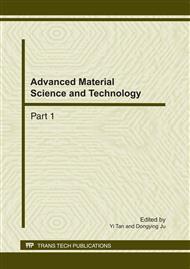p.61
p.65
p.69
p.73
p.77
p.81
p.85
p.89
p.93
Preparation and Characteristics of FePO4·xH2O Powder
Abstract:
Nano-sized precursor FePO4·xH2O particles were obtained by oxidation co-precipitation using FeSO4⋅7H2O, H2O2 and ammonia. The powder was characterized by differential thermal analysis (DTA) and thermogravimetry (TG), scanning electron microscopy (SEM) and X-ray diffraction (XRD). The TG-DTA results determined the content of crystal water of FePO4·xH2O, i.e. x = 1.5. The SEM observation suggested that FePO4·xH2O particles were spherical in shape and its grain size was about 150 nanometers. The dispersion of the synthesized powder was improved through the addition of surfactant. The XRD analysis indicated that the synthesized FePO4·xH2O was amorphous. After being calcined at 720 °C for 10 hrs, the synthesized FePO4·xH2O at pH of ~3.5 was crystallized and FePO4 in a single phase was obtained. According to the test results, the optimized preparation process parameters were determined.
Info:
Periodical:
Pages:
77-80
Citation:
Online since:
February 2011
Authors:
Keywords:
Price:
Сopyright:
© 2011 Trans Tech Publications Ltd. All Rights Reserved
Share:
Citation:


